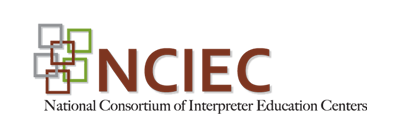VRS / VRI
Video Interpreting Practice
Video Relay Service (VRS) interpreting, beginning in the mid-1990’s, is now considered commonplace in the United States. More recent, yet fast growing is Video Remote Interpreting (VRI). VRS and VRI allows people who are Deaf and use sign language to make telephone calls or to or interact with hearing people by working with video interpreters. Both VRS interpreters and VRI interpreters rely on video equipment and the internet to accomplish their work, with distinct differences. VRS interpreters facilitate telephone communication between people in separate locations, while VRI interpreters facilitate all types of communication between people in the same location, or different locations.
About the Video Interpreter
Video interpreting requires highly skilled and experienced interpreters to provide access between Deaf, hard of hearing, and hearing individuals. The highly demanding and complex work of the video interpreter requires experience and skill. In the 2007 NCIEC Interpreting Practitioner Needs Assessment (Cokely & Winston, 2007), interpreters identified working in video relay service settings as one of the priority education and training areas for the future.
Reference: Cokely, D. & Winston, E (2007). NCIEC Interpreting Practitioner Needs Assessment: Final Report. National Consortium of Interpreter Education Centers.
Consortium’s Work on Video Interpreting
In 2009, according to a National Interpreter Education Center needs assessment survey (NCIEC 2010), about 16% of interpreters spent 50% or more of their practice working via video. From 2005-2010, a Consortium work-team collaborated with partners and stakeholders to document standard practice, identify best practices, and outline effective practices of interpreters working via video technology, and promote inclusion of these findings in interpreter education. In September 2007, the Consortium convened a summit – the first of its kind – titled Academia-Industry Collaboration: An Essential Partnership for Preparing Qualified Personnel Resources for the Video Relay Services Industry. This was a first step in identifying current and effective practices, as well as educational and training needs to support interpreters in mastering requisite competencies to work in these settings. The Consortium focused on identifying common needs and issues of the industry as a way to provide input to Interpreter Education regarding essential educational and training needs of interpreters working in video settings.
Gallaudet University in Washington, D.C., U.S., also hosted the first-ever National Symposium on Video Interpreting: The State of the Practice and Implications on May 23-25, 2010. During the symposium, cutting-edge research was presented on the state of the practice and highlighted the unique aspects of working via video as well as the issues that impact this work.
Reference: Cokely, D. & Winston, E (2010). Interpreter Practitioner Needs Assessment Trends Analysis: Final Report. National Consortium of Interpreter Education Centers.
Building upon the work of the Interpreting via Video Work Team during the past grant cycle, the Center at Gallaudet University (GURIEC) designed curriculum for instruction on several aspects of effective practice in VRS interpreting. The curriculum was used for a pilot course at Gallaudet. In 2012, Gallaudet hosted another national symposium on video interpreting. Many of the presentations from the symposium are available in GURIEC’s Presentation Archives. In 2014, a Video Interpreting track was included in Gallaudet’s first International Symposium on Interpreting and Translation Research. A volume of selected papers from the international symposium will be published by Gallaudet Press. Finally, GURIEC developed a Video Interpreting Repository, which catalogued resources, research, and news about video interpreting.
Resources
A Collaborative Approach Identifying Effective Practices of Video Remote Interpreters, RID 2009 PowerPoint Presentation.
Interpreting via Video Work Team. (2007). Video relay service industry research, training and material needs. National Consortium of Interpreter Education Centers.
Interpreting via Video Work Team. (2007). Video relay service interpreting domains and competencies. National Consortium of Interpreter Education Centers.
Interpreting via Video Work Team. (2008). Steps toward identifying effective practices in video relay interpreting. National Consortium of Interpreter Education Centers.
Interpreting via Video Work Team. (2009).VRS Bibliography: Collaborative Approach to Effective Practice Research on VRS Interpreting. National Consortium of Interpreter Education Centers.
Interpreting via Video Work Team. (2010). Steps toward identifying effective practices in video remote interpreting. National Consortium of Interpreter Education Centers.
Lightfoot, M.H. (2007). Interpreting culturally sensitive information in VRS settings. RID VIEWS, June 1, 17.
RID, Inc. (2007) Video Relay Service Standard Practice Paper.
RID, Inc. (2010). Video Remote Interpreting Standard Practice Paper.
Taylor, M. (2005). Video Relay Services Interpreting Task Analysis Report. Distance Opportunities for Interpreting Training Center, University of Northern Colorado.
Witter-Merithew, A. & Johnson, L. J. (2005). Toward competent practice: Conversations with stakeholders. Alexandria, VA: Registry of Interpreters for the Deaf.
